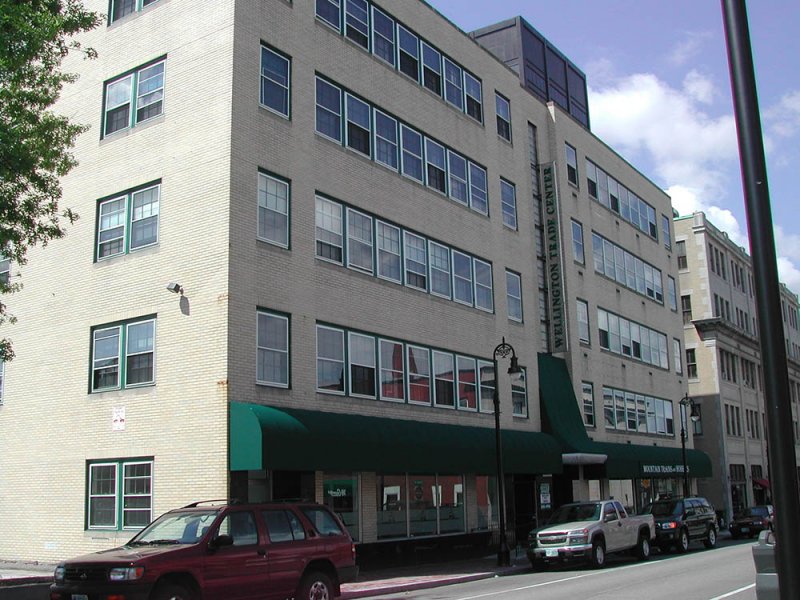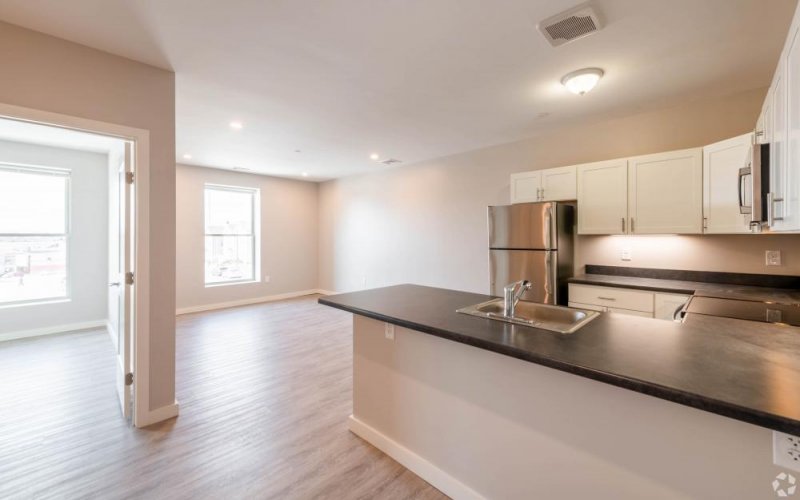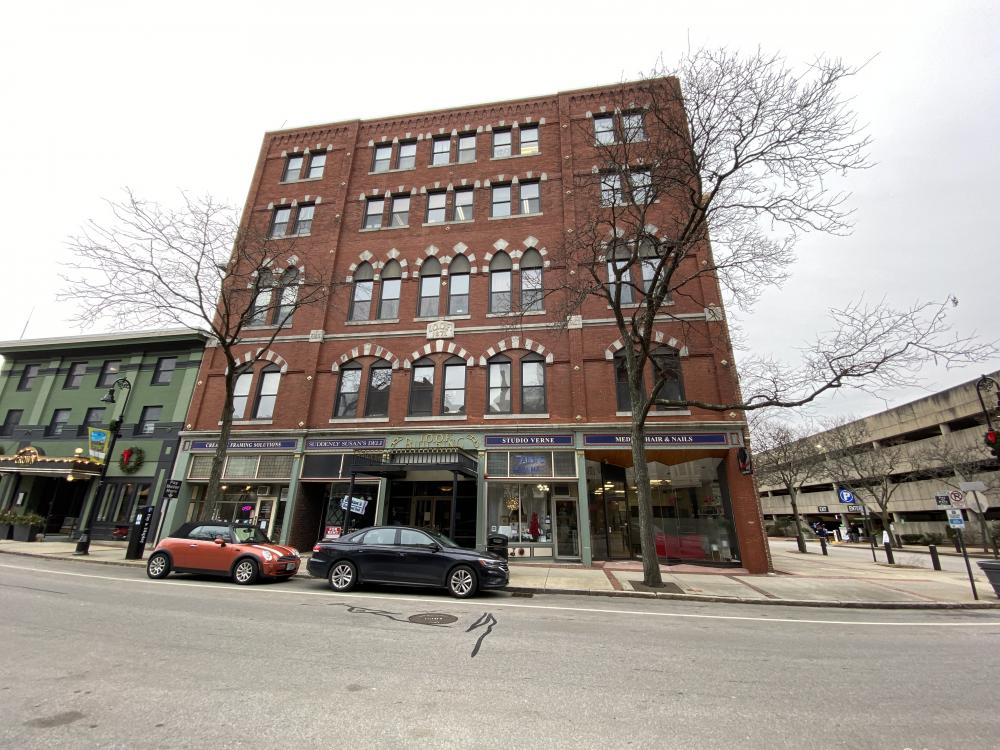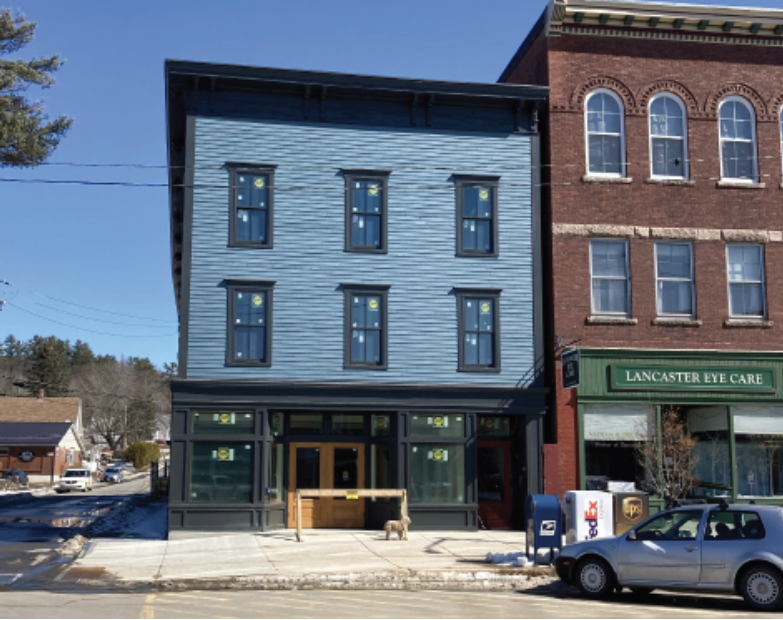 Gamache Properties is currently converting the Wellington Trade Center in to apartments with first-floor retail. (Gamache properties)
Gamache Properties is currently converting the Wellington Trade Center in to apartments with first-floor retail. (Gamache properties)
It sounds like a no-brainer: More than 10% of NH’s office stock sits vacant, while the state sags under a housing shortage that deters would-be workers and constricts the economy. So why not convert some of that unused office space into much-needed housing units for a win-win?
Many developers and even some nonprofits are doing exactly that, taking on obstacles ranging from design challenges to antiquated zoning regulations.
“We’re kind of expecting it to be a trend,” says Ben Frost, deputy executive director and chief legal officer of NH Housing. With more people working at home, “what we will see probably over time is a gradual diminution of the use of office space even as we continue to do face-to-face work, so there will be a more flexible work environment,” Frost says.
Those vacant office spaces, he adds, will be available for conversion “and that’s a hopeful sign because we certainly need more space for housing.”
Severe Housing Shortage
The 2023 Statewide Housing Needs Assessment, prepared for NH Housing, spells out the need: a projected 60,000 housing units are needed between 2020 and 2030, and 90,000 between 2020 and 2040, including the current shortage of 23,500 units needed to stabilize the
housing supply.
Housing remains a top priority for the state’s employers, according to David Juvet, senior vice president of public policy at the Business & Industry Association of NH, because “there is broad recognition that in order to retain the current workforce and attract new workers, there has to be a place for these people to live.”
Office Conversions Across NH
The state’s office vacancy rate stood at 10.7% at the end of 2022, according to Colliers, the international firm that tracks market changes. That was an improvement of 0.7% over the previous year, owing in part to some of those residential conversions.
Major urban areas like Manchester, Concord and Nashua have seen the greatest number of office-to-housing projects, but such transitions are happening even in rural Coos County in the northern part of the state.
In Manchester, the 10-story building at Hanover and Elm streets, originally built in 1913 for Amoskeag Bank, was converted to 91 luxury apartments and retail space in 2016, while the former Pearson’s Jewelers Building on Elm Street was redeveloped in 2018-19 as a 32-unit, mixed-use apartment building, called Pearson’s Place.
When COVID and its aftermath started pushing up office vacancy rates, Manchester real estate developer Ben Gamache says he decided to convert any buildings he owned with less than 50% occupancy into apartments. “Manchester is in need of apartments so we thought that would be a good idea,” he says.
Gamache turned vacant office space above a restaurant at 62 Lowell St. into nine apartments in 2022 and did the same with a nearly vacant office building at 540 Chestnut St. in fall 2021, creating 12 two-bedroom apartments.
His company is now refurbishing a former office building at 530 Chestnut St. into 12 one-bedroom apartments and is converting the Wellington Trade Center at 25 Lowell St. into 46 apartments, with retail on the first floor.
 Gamache Properties converted a vacant office building at 540 Chestnut St. in Manchester into 12 two-bedroom apartments. (Gamache properties)
Gamache Properties converted a vacant office building at 540 Chestnut St. in Manchester into 12 two-bedroom apartments. (Gamache properties)
Elm Grove Companies has also been an active player in the conversion business in both Manchester and Concord. In addition to the Pearson’s Place project in Manchester, the company recently transformed an old brick building in the heart of downtown Concord into The Lofts at Star Theater, featuring 12 lofted apartments. It also renovated the 1911 Kearsarge Building, a one-time luxury apartment building later used for office space, into 27 modern apartments.
Chris Schleyer, principal and head of property management for Elm Grove Companies, says the firm’s first such project was The Flats at Hanover Commons at 235 Hanover St. in Manchester, built in the 1800s as a large apartment building, later used as a dormitory for hospital staff, and still later as a drug and alcohol rehabilitation center. Elm Grove purchased the property in 2017 and converted it into 35 micro apartments of about 350 square feet each with modular furniture and high-end amenities.
“We wanted to rent a luxury apartment for lower rent than one-bedroom or two-bedroom apartments,” Schleyer explains. Rents start at $1,150, according to the company website. And the conversion has been a success with The Flats fully rented.
“We believe strongly in the strong towns model,” he adds. “You need to have a good strong mix of retail and residential downtown. It leads to walkability and a more vibrant downtown. We wanted to be a part of doing something that would help Manchester move closer in that direction. Those properties were vacant, and we had the ability to convert them.”
Brady Sullivan Properties has also transformed former mill space into housing in several NH communities. Among them are Manchester complexes like the 110-apartment Lofts at Mill No. 1 on Bedford Street, the Lofts at Mill West, and The Lofts at Jefferson Mill, as well as Colony Mill in Keene, 25 Canal in Allenstown, and Lofts 34 in Nashua, among others.
Last year, Red Oak Apartment Homes won approval from the zoning board to retrofit the Independent Order of Odd Fellows Building at 73 Hanover St. into 43 units, adding to its list of residential properties in downtown Manchester.

And it is not only developers who are making such transitions.
In the North Country, the nonprofit Northern Forest Center recently converted a dilapidated, 11,000-square-foot structure, the Parker J. Noyes Building, into six apartments and retail space on Lancaster’s Main Street.
Challenges
Turning office space into housing has its challenges. Tracy Kozak, founding principal at ARCove Architects in Portsmouth, immediately rattles off three: parking, daylight,
and safety.
She is the architect for a project at 1 and 3 Congress St. in Portsmouth to renovate two 1900-era buildings into 18 apartments, with retail on the first floor and office space on the second.
Because Portsmouth’s downtown overlay district requires parking for housing projects but not office space, “we had to limit the number of apartments based on how much parking we could fit underground,” she explains. “They’re big apartments. We could have made apartments that were smaller and more affordable, but we couldn’t get the parking. Parking is affecting the affordability of life.”
Another issue involves the width of the building. If the building is too wide, which many modern office buildings are, they are more difficult to convert to apartments and often are passed over for such conversions, says John Stebbins, managing director of PROCON.

Northern Forest Center recently converted the dilapidated Parker J. Noyes Building on Lancaster’s Main Street into six apartments and retail space. (John W. Hession/courtesy of the Northern Forest Center)
Stebbins points to the Liberty Mutual campuses in Dover that went on the market in January. While those 350,000 and 250,000 square foot buildings come with plenty of parking, they are 120 feet wide. “The parking lots at these offices are enormous, but the buildings are double the width of what would typically be wanted for a residential apartment building,” Stebbins says, adding that a width of 60 to 70 feet is a more ideal range. “If a unit is too deep it becomes like a bowling alley, and no one wants a space with no windows. The [Liberty Mutual land] is more valuable than the buildings because they just don’t work dimensionally.”
Indeed, many office spaces are built “as giant boxes,” Kozak says, and are too wide to allow much daylight in every room “because a room in a house is not 150 feet wide,” she says. Adding more windows is an obvious but expensive remedy. Frost at NH Housing says some developers are also addressing the issue by adding central atriums or courtyards to renovation designs to allow for more light.
Kozak says that safety concerns like sprinkler systems and additional exits can complicate renovations, as can the need for more bathrooms and showers in a building not originally designed for apartments.
She also sees a need for architects to incorporate more workspaces into apartment design to accommodate the increased number of people working from home.
Local Regulations Pose Problems
In addition to meeting standard planning and zoning requirements, Schleyer notes that developers must pay municipalities impact fees based in part on the number of children a project is expected to bring into the local school system. If a proposed project has only one-bedroom apartments, the developer may negotiate lower impact fees on the grounds that no or few children are likely to be added to the local school population.
Dick Anagnost, president of Anagnost Investments, a real estate and land development company in Manchester, says zoning is the biggest obstacle when it comes to renovating office space into residential. “Rarely does a commercial district allow for development,” he says, explaining that all the attributes that make a building viable for conversion can be in place including the price, the location of utilities, and adequate parking, “but going to the planning board is another issue.”
“If you’re successful getting a change of use permit and/or variance, a site plan approval can take six months to a year or even longer,” Anagnost says. “There’s a lot of upfront work to get approvals.”
Frost says it may be time for municipalities to take a new look at longstanding regulations. “We typically have zoning that is ossified—residential here and office over there,” he says. “That separation of uses, which is the hallmark of traditional zoning, has gone by the wayside from a development standpoint and municipal regulation is catching up with that. You may have a vacant office building that is fine that can’t be used for residential because it isn’t zoned for it. Let the market figure out how these properties should be used.”
So is it worth it? Is repurposing an office building for housing less expensive than building from scratch?
Many developers say it depends on the property, but Schleyer finds it cost-effective by a guestimate of 15%. He says exteriors of such a property do not require as much work, though items like windows and mechanical, electrical, and plumbing can add to cost. “There’s a lot of cost on the front end with new construction, a lot of expense before you ever break ground, then you bring in water, sewer, foundations.”
He adds that the push toward converting office buildings into housing may eventually wane. “All of these decisions are market-driven,” says Schleyer, “and some day we may be converting apartments into office space.”
Anagnost, who has redeveloped multiple properties in Manchester’s Millyard area and all over the city, says in the end the ways in which available office spaces will be used comes down to building design and creativity. He points to office space in Massachusetts and Florida that were recently turned into gyms. “You need to know what the area is zoned for and how wide it can be opened up,” he says. “Being creative is what real estate developers do.”
Staff Writer Scott Merrill contributed to this story.

 Current Issue - July 2024
Current Issue - July 2024